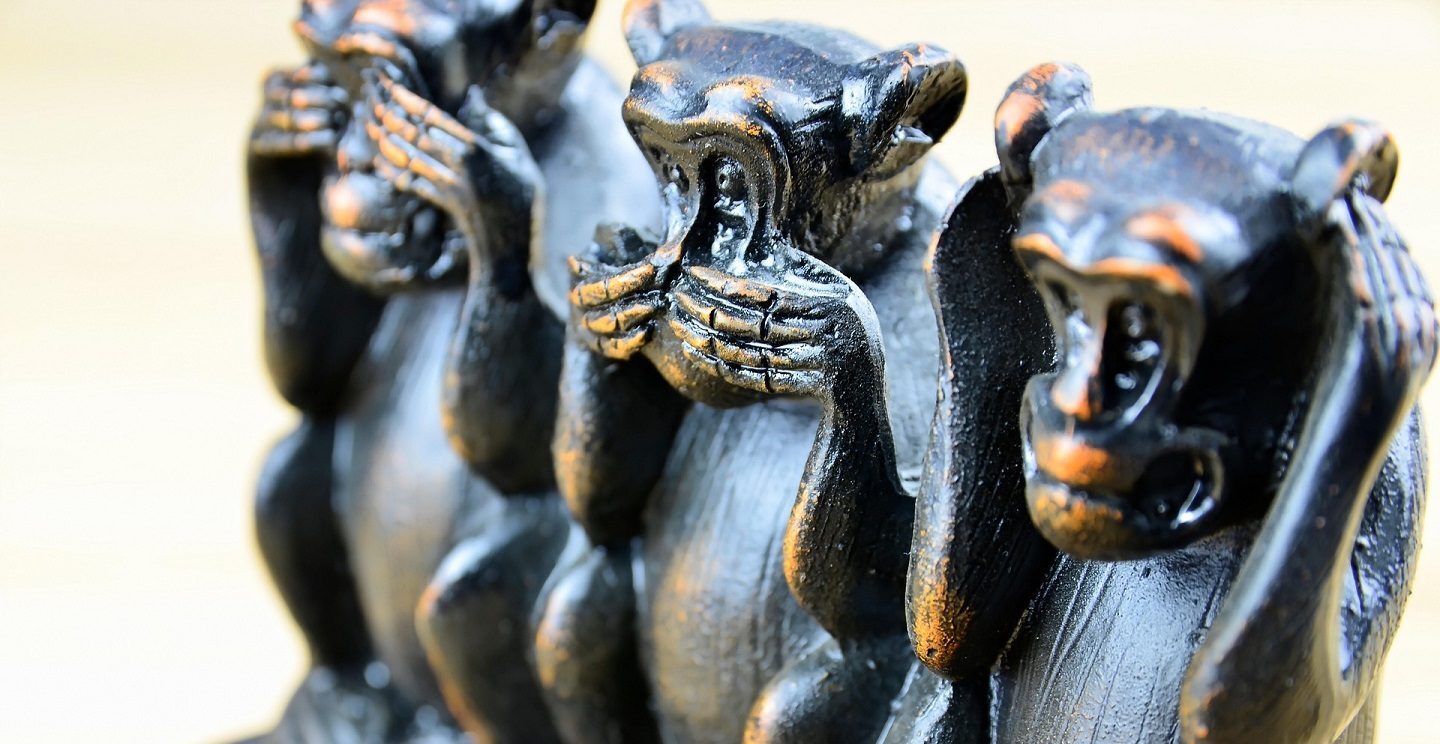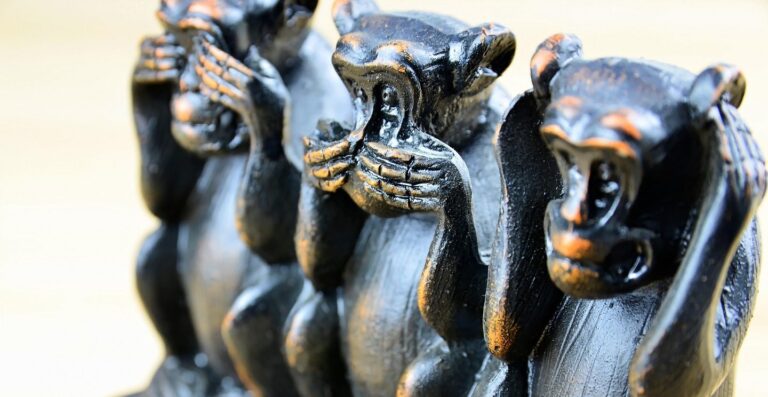While meditating on the best way to meet the turbulent waves of socio-political change we are facing globally, the phrase “See no evil, hear no evil, speak no evil” came to me. Assuming that this could be a wise choice, how would one understand this saying, especially when the public space is dominated by strong reactions and warnings that anything else is dangerous?
The age-old adage “See no evil, hear no evil, speak no evil” is a cultural Rorschach test—its meaning shifting dramatically based on the lens through which we view it. While most recognize the three monkeys covering eyes, ears and mouth, few realize this symbol acomodates three distinct philosophical interpretations that reveal fundamental differences in how humans relate to morality itself.
The Western Lens: Strategic Ignorance
In contemporary Western culture, the maxim often carries cynical undertones. We see it invoked when corporations ignore ethical violations for profit, politicians “mishear” inconvenient truths, or witnesses stay silent to abusive situations. This interpretation frames the monkeys as symbols of self-preservation through deliberate obliviousness—a survival tactic in competitive environments where speaking up risks social or financial capital.
The limitation here is clear: While protecting short-term interests, this approach perpetuates systems of harm. Like a magnified bystander effect, it creates cultures where evil thrives in the spaces between averted gazes.
The Buddhist Path: Karmic Hygiene
Tracing the proverb to its Eastern roots reveals a more nuanced meaning. Originating from 17th-century Japanese carvings at the Tōshō-gu Shrine in Nikkō, the three monkeys (Mizaru, Kikazaru, Iwazaru) represented a spiritual hygiene practice. By avoiding exposure to negative influences, practitioners sought to prevent “Sanshi”—the three worms of greed, hatred, and delusion—from corrupting their karma.
This approach, while morally proactive, still operates within dualistic thinking. Good and evil remain fixed categories to navigate strategically. Like using earplugs in a toxic environment, it protects the listener but doesn’t transform the noise itself.
The Nondual Perspective: Seeing Through the Illusion
A radical third interpretation emerges from nondual wisdom traditions. Here, the monkeys’ gestures symbolize not denial but transcendence of the good/evil dichotomy itself. When we recognize consciousness as the fundamental reality, apparent “evils” become:
- Distortions of perception (covered eyes). We do not see what is real (consciousness) and are fooled by the many forms it temporarily takes.
- Misinterpretations of meaning (covered ears). We do not hear the harmony of the entirety and only perceive dissonance whenever we hold on to our limited personal perspective.
- Labels created by language (covered mouth). If we believe in evil, we forget that we create our reality through language.
From this vantage point, actions arise no longer from moral calculations but spontaneous compassion. A nondual entrepreneur might expose corporate corruption not to “fight evil” but because truthfulness feels as natural as breathing. An activist responds to injustice not with hatred but the tender care one shows a feverish child.
Why This Matters
The nondual interpretation offers three huge advantages to anyone who embraces it:
The first advantage is sustainable engagement: Without demonizing opponents, we avoid burnout from a perpetual “fighting” mentality.
The second advangtage is creative solutions: Seeing beyond good/evil categories reveals new resolutions invisible to dualistic thinking.
The third advantage is emotional freedom: Recognizing the relative nature of morality liberates us from judgment—both of others and ourselves. It allows us to remain in the healthy space of individual and collective wellness and invite others to join.
Nondual Wisdom in Daily Practice
The transcendent identity perspective isn’t about passive withdrawal. What it leads to is engaged clarity. Here are a few scenarios:
Family Conflicts
When mediating disputes about social issues, the nondual approach might involve:
- Listening to polarized views without mentally categorizing “right” or “wrong” sides
- Asking “What values are trying to emerge here?” rather than “Who’s being unreasonable?”
- Modeling calm presence that dissolves tension better than any argument
Workplace Ethics
Facing pressure to compromise values, a nondual response could look like:
- Addressing harmful policies through system redesign rather than shaming individuals
- When reporting misconduct, framing it as “This doesn’t align with our shared purpose” vs. “You’re unethical”
- Transforming whistleblowing from attack to invitation for collective growth
Digital Citizenship
In online spaces filled with moral outrage, one might:
- Pause before sharing condemnatory content – not from censorship, but to ask “Does this amplify understanding?”
- Respond to aggressive comments with curiosity: “Your passion shows this matters deeply—help me understand your perspective.”
- Recognize viral shaming campaigns as modern witch trials and find ways to address and rectify harm without creating new victims.
Activism Reimagined
Protesters using this approach might:
- Frame social or ecological destruction not as “corporate evil” but collective trauma response
- Find ways to help executives feel human and ecological interconnection
- Replace “We demand change!” with “Let’s work for solutions that sustain all life”
Nondual wisdom could be showing us a way to create a better world not by fighting for it from our pain and lack, but by letting it manifest from our inner, authentic goodness. In covering their senses, the monkeys might be inviting us to stop relying on moral ammunition and instead connect with the wisdom that knows when to act—and when simple presence is the greatest healing.
To me, the three monkeys have become a reminder that wisdom lies not in how we habitually oppose, but in how we mindfully meet any situation. In a world shouting demands for moral side-taking, their silent gesture is subtly revolutionary—an invitation to respond from depths beyond reaction, where healing arises not from doing what we are conditioned to believe is right, but from being the space where right action emerges naturally.
 Aurora Carlson is an Ayurvedic counselor, meditation teacher, social worker, linguist, and the Chopra Foundation regional advisor for Sweden. Visit her on: auroracarlson.com.
Aurora Carlson is an Ayurvedic counselor, meditation teacher, social worker, linguist, and the Chopra Foundation regional advisor for Sweden. Visit her on: auroracarlson.com.






